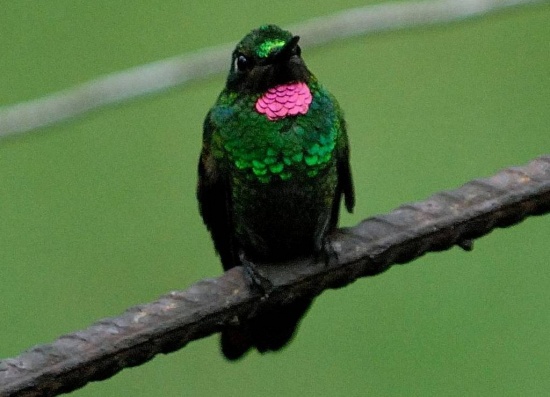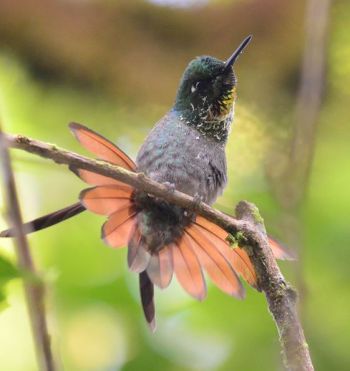m (→Habitat) |
(Genus change. References updated. New GSearch and GSearch checked template. Pictures dated) |
||
| (2 intermediate revisions by one other user not shown) | |||
| Line 1: | Line 1: | ||
| − | [[Image:20853DSC 00140001.JPG|thumb|550px|right|Male<br />Photo © {{user|Luiz|Luiz}}<br />Serrinha do Alambari, Resende, Rio de Janeiro, [[Brazil]], September 2006]] | + | [[Image:20853DSC 00140001.JPG|thumb|550px|right|Male<br />Photo © {{user|Luiz|Luiz}}<br />Serrinha do Alambari, Resende, Rio de Janeiro, [[Brazil]], 7 September 2006]] |
| − | ;[[: Category: | + | ;[[: Category:Heliodoxa|Heliodoxa]] rubricauda |
| − | '' | + | ''Clytolaema rubricauda'' |
==Identification== | ==Identification== | ||
| − | 11 cm (4.3 | + | 11 cm (4.3 in)<br /> |
Both sexes have a straight, black bill and a white spot behind the eye.<br /> | Both sexes have a straight, black bill and a white spot behind the eye.<br /> | ||
The '''male''' is mainly green with a ruby-red throat (for which this hummingbird is named) and greyish speckling on the belly. The tail and the lower back is coppery-rufous.<br /> | The '''male''' is mainly green with a ruby-red throat (for which this hummingbird is named) and greyish speckling on the belly. The tail and the lower back is coppery-rufous.<br /> | ||
Melanistic males are seen frequently (not completely black but darker than normal).<br /> | Melanistic males are seen frequently (not completely black but darker than normal).<br /> | ||
| − | [[Image:3468brazilian ruby female.jpg|thumb|350px|right|Female<br />Photo © {{user|pbono|pbono}}<br />Itatiaia National Park, Rio de Janeiro, [[Brazil]], November 2003]] | + | [[Image:3468brazilian ruby female.jpg|thumb|350px|right|Female<br />Photo © {{user|pbono|pbono}}<br />Itatiaia National Park, Rio de Janeiro, [[Brazil]], November 2003 <!--EDITORS: this image does not appear in the Gallery-->]] |
The '''female''' is green with a small whitish-buff streak at the bill-base and light cinnamon underparts. The tail is mainly rufous from below, central tail feathers coppery-green from above.<br /> | The '''female''' is green with a small whitish-buff streak at the bill-base and light cinnamon underparts. The tail is mainly rufous from below, central tail feathers coppery-green from above.<br /> | ||
'''Immatures''' resemble the female, but are speckled with rufous-buff on the upperparts. | '''Immatures''' resemble the female, but are speckled with rufous-buff on the upperparts. | ||
| Line 19: | Line 19: | ||
==Habitat== | ==Habitat== | ||
Forest, parks, scrub, plantations. Mainly in lowlands, but locally as high as 1500-2000 m. (4900-6500 ft.) [[Dictionary_A-C#A|asl.]] Generally common. | Forest, parks, scrub, plantations. Mainly in lowlands, but locally as high as 1500-2000 m. (4900-6500 ft.) [[Dictionary_A-C#A|asl.]] Generally common. | ||
| − | [[Image:Brazilian_Ruby.jpg|thumb|350px|right|Male<br />Photo © {{user|Luiz|Luiz}}<br />Serrinha do Alambari, Resende, Rio de Janeiro, [[Brazil]], August 2006]] | + | [[Image:Brazilian_Ruby.jpg|thumb|350px|right|Male<br />Photo © {{user|Luiz|Luiz}}<br />Serrinha do Alambari, Resende, Rio de Janeiro, [[Brazil]], 25 August, 2006]] |
==Behaviour== | ==Behaviour== | ||
| Line 26: | Line 26: | ||
Mainly feeds on nectar, less frequently small insects. Regularly attend hummingbird feeders. | Mainly feeds on nectar, less frequently small insects. Regularly attend hummingbird feeders. | ||
====Breeding==== | ====Breeding==== | ||
| − | Breeding Nov-March. The two eggs are laid in a cup-shaped nest 3-10 m. (10-30 ft) above the ground. | + | Breeding Nov-March. The two eggs are laid in a cup-shaped nest 3-10 m. (10-30 ft.) above the ground. |
==References== | ==References== | ||
| − | #{{Ref- | + | #{{Ref-Clements6thOct22}}#{{Ref-vanPerloBrazil09}}#Schuchmann, K.L. and G. M. Kirwan (2020). Brazilian Ruby (Clytolaema rubricauda), version 1.0. In Birds of the World (J. del Hoyo, A. Elliott, J. Sargatal, D. A. Christie, and E. de Juana, Editors). Cornell Lab of Ornithology, Ithaca, NY, USA. https://doi.org/10.2173/bow.brarub1.01 |
{{ref}} | {{ref}} | ||
==External Links== | ==External Links== | ||
| − | {{GSearch|Clytolaema | + | {{GSearch|"Heliodoxa rubricauda" {{!}} "Clytolaema rubricauda" {{!}} "Brazilian Ruby"}} |
| − | [[Category:Birds]][[Category: | + | {{GS-checked}} |
| + | <br /> | ||
| + | <br /> | ||
| + | |||
| + | [[Category:Birds]][[Category:Heliodoxa]] | ||
Latest revision as of 12:37, 4 January 2023
- Heliodoxa rubricauda
Clytolaema rubricauda
Identification
11 cm (4.3 in)
Both sexes have a straight, black bill and a white spot behind the eye.
The male is mainly green with a ruby-red throat (for which this hummingbird is named) and greyish speckling on the belly. The tail and the lower back is coppery-rufous.
Melanistic males are seen frequently (not completely black but darker than normal).
The female is green with a small whitish-buff streak at the bill-base and light cinnamon underparts. The tail is mainly rufous from below, central tail feathers coppery-green from above.
Immatures resemble the female, but are speckled with rufous-buff on the upperparts.
Distribution
Endemic to south-east Brazil from Espirito Santo in north to Rio Grande do Sul in south and Goias in west.
Taxonomy
This is a monotypic species[1].
Habitat
Forest, parks, scrub, plantations. Mainly in lowlands, but locally as high as 1500-2000 m. (4900-6500 ft.) asl. Generally common.
Behaviour
Territorial behavior is common especially in males and to lesser extent, females.
Diet
Mainly feeds on nectar, less frequently small insects. Regularly attend hummingbird feeders.
Breeding
Breeding Nov-March. The two eggs are laid in a cup-shaped nest 3-10 m. (10-30 ft.) above the ground.
References
- Clements, J. F., T. S. Schulenberg, M. J. Iliff, T. A. Fredericks, J. A. Gerbracht, D. Lepage, S. M. Billerman, B. L. Sullivan, and C. L. Wood. 2022. The eBird/Clements checklist of Birds of the World: v2022. Downloaded from https://www.birds.cornell.edu/clementschecklist/download/
- Ber van Perlo. 2009. A field guide to the Birds of Brazil. Oxford University Press, New York, NY, USA. ISBN 978-0-19-530155-7
- Schuchmann, K.L. and G. M. Kirwan (2020). Brazilian Ruby (Clytolaema rubricauda), version 1.0. In Birds of the World (J. del Hoyo, A. Elliott, J. Sargatal, D. A. Christie, and E. de Juana, Editors). Cornell Lab of Ornithology, Ithaca, NY, USA. https://doi.org/10.2173/bow.brarub1.01
Recommended Citation
- BirdForum Opus contributors. (2024) Brazilian Ruby. In: BirdForum, the forum for wild birds and birding. Retrieved 14 June 2024 from https://www.birdforum.net/opus/Brazilian_Ruby
External Links
GSearch checked for 2020 platform.







